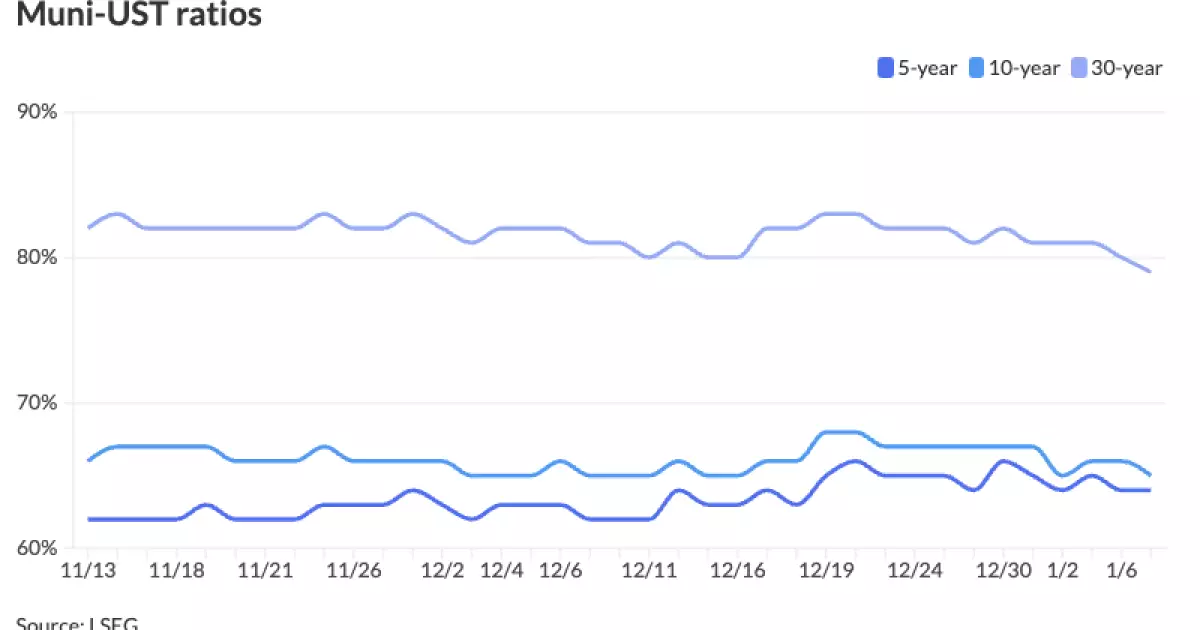The municipal bond market plays a crucial role in the financial ecosystem, offering a means for state and local governments to finance public projects while providing investors with tax-exempt income. In recent weeks, the market has demonstrated both resilience and complexity against a backdrop of fluctuating U.S. Treasury yields. This article explores the latest trends in municipal bonds, including yield movements, investor sentiment, and the factors shaping the supply-demand dynamics.
On a recent Tuesday, the municipal bond sector displayed a mixed performance; however, it significantly outperformed U.S. Treasury securities. While municipal yields remained largely flat, UST yields saw considerable increases, with 10-year bonds rising by eight basis points. This divergence in performance illustrates investor preferences leaning towards municipal bonds, particularly given the steady ratios between different maturities—64% for two and five-year bonds, climbing to 79% for 30-year bonds.
These yield ratios are essential indicators for market analysts, as they help gauge relative value between municipal securities and taxable alternatives. The favorable ratios indicate a stable demand from buyers despite broader financial market volatility. Such a landscape is ripe for municipal bonds, especially leading into 2025, where analysts predict a record-breaking issuance calendar prompted by continued demand for tax-exempt options.
In light of mounting demand, underwriters are urged to proceed cautiously. Matt Fabian from Municipal Market Analytics highlights the potential pitfalls associated with aggressively low yield offerings. With surging retail interest following December’s yield spikes—evidenced by a significant volume of trades—there is a risk that pushing yields down too rapidly could lead to pushback from investors. The impending market conditions, especially leading up to a potentially unbalanced U.S. budget and possible changes in tax policy, render it more crucial for underwriters to remain vigilant.
Amid these pressures, the forecast for new issue supply remains robust, particularly with predictions of $27 billion in maturing bonds set to renew investor interest moving into the new year. This vibrant demand, coupled with a substantial $9.64 billion sitting in the 30-day visible supply, intensifies the competition among issuers for investor capital.
Although the outlook for municipal bond issuance is positive, analysts caution about the potential burdens posed by expectations of “exuberant” supply. With the record issuance of over $500 billion in 2024, the anticipated influx of new bonds could pressure yields if broader market conditions do not hold firm. Recent trends showing weaker net asset value (NAV) performance in mutual funds suggest a potential hesitance among buyers, leading to questions about consistent retail participation.
Additionally, recent outflows from mutual funds further illuminate the precarious nature of investor confidence. As strategists from DWS conveyed, volatility in Treasury rates alongside alternative investment distractions may temper investments into the municipal bond market. Despite this, the evolving dynamics may also signal opportunities for savvy investors to capitalize on attractive yields, especially if they arise from heightened issuance in 2025.
A pivotal factor influencing the municipal bond market is the anticipated changes to tax regulations, which could drastically reshape the investment landscape. Banks and insurers have seen diminishing municipal holdings since the last electoral cycle, thereby shifting the buyer base predominantly towards retail investors. Amidst ongoing legislative discussions that prioritize issues such as immigration and tariffs, there exists urgency among issuers to enter the market early in the year. This preemptive strategy aims to circumvent potential fallout from impending tax reforms that could negatively affect certain sectors.
Market participants also highlight potential surge scenarios later in the year, driven by modified tax code impacts, particularly for private activity bonds and higher education financing. The dynamic interplay of supply and demand will need to be managed carefully to achieve optimal outcomes for issuers and investors alike.
The municipal bond market stands at a fascinating crossroads, characterized by strong demand, cautious underwriter strategies, and a crucible of potential challenges ahead. As we navigate into 2025, it will be essential for stakeholders to stay attuned to market signals, legislative changes, and evolving investor sentiments. The construction of a formidable new-issue calendar, married with adaptive strategies by underwriters and a vigilant approach by investors, holds the potential to translate these challenges into opportunities, ultimately sustaining the robust character of the municipal bond market.

